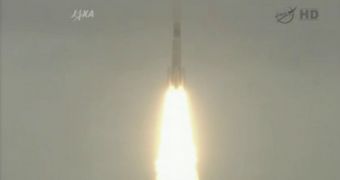Officials at the Japan Aerospace Exploration Agency (JAXA) say that the third H-II Transfer Vehicle (HTV-3) space capsule launched successfully from the Tanegashima Space Center. Takeoff occurred at 11:06 am Japan time (0206 GMT) today, July 21.
The vehicle, whose name means White Stork in Japanese, is scheduled to spend the next week in orbit, as it slowly makes its way in the same orbit as the International Space Station (ISS). HTV-3 is carrying supplies for the Expedition 32 crew.
These include food, water, fuel for the station's maneuvering thrusters, as well as a series of scientific experiments to be installed on the orbital lab. The pressurized cargo bay also includes some personal items for the six astronauts currently on the ISS.
The JAXA spacecraft was launched to space aboard an H-2B rocket, and is the third in a series of resupply flights conducted by Japan. The first two took place in September 2009 and January 2011.
HTV-3 is scheduled to meet up with the orbital lab on July 27, when it flies to within 12.2 meters (40 feet) of the station. Expedition 32 astronauts will use the CSA-built Canadarm-2 robotic arm to grapple the resupply capsule, and then dock it to the American Harmony module.
JAXA astronaut Aki Hoshide and NASA astronaut Joseph Acaba will be responsible for operating the robotic arm during the 90-second window of opportunity the ISS crew has for capturing HTV-3.
If for some reason they fail to grab the vehicle, then the latter will be lost. The capsule is filled with around 4 tons of cargo, which are very important for the success of the current astronaut crew, Space reports.
The next resupply flight to the ISS will be the Russian Federal Space Agency's (RosCosmos) Progress M-16M unmanned capsule, which will take off from the Baikonur Cosmodrome, in Kazakhstan, on August 1.
The flight will be the first where RosCosmos attempts to dock its spacecraft to the ISS in the same day as the launch. The space agency is interested in reducing the typical, 2-day interval it currently requires to position its vehicles correctly ahead of a docking attempt.
At this time, only Russian-built Soyuz space capsules can delivery astronauts to the ISS. Cargo is taken to orbit aboard Japanese HTV, European Automated Transfer Vehicles (ATV), Russian Progress capsules and the private Dragon space capsules, built by Hawthorne, California-based SpaceX.

 14 DAY TRIAL //
14 DAY TRIAL //